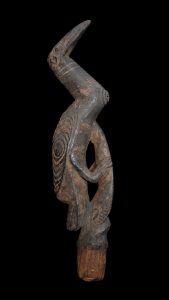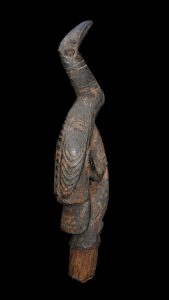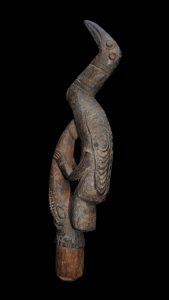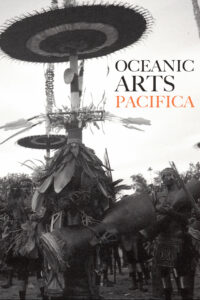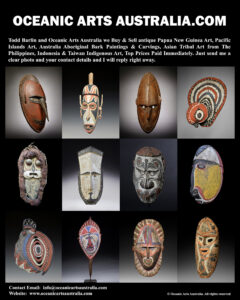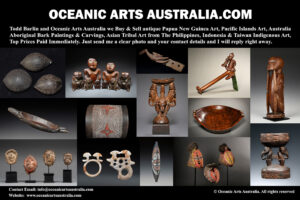A Fine Old New Guinea Flute Stopper Middle Sepik River Area of Papua New Guinea
| Collection No. | TB-2922 |
|---|---|
| Size | Height 26cm |
A Fine Old New Guinea Flute Stopper Middle Sepik River Area of Papua New Guinea
This older and used Flute Stopper is from the Sawos People in the Middle Sepik River area of Papua New Guinea. In the form of totemic animals a bird perched on the top of a crocodile’s head. The back of the bird has finely incised designs and the whole object has a deep old crusty patina. The Flute Stopper dates from the late 19th – early 20th Century as it was collected in the Sepik River area in the 1930s
For many New Guinea peoples, flutes are among the most sacred and important of all musical instruments. Sacred flutes were made from hollow cylinders of bamboo and played, like a Western flute, by blowing through a hole in the side of the instrument near the upper end. The tops of these flutes were frequently decorated with ornamental flute stoppers like this example. Some of the finest artworks made in the Sepik River area were the sacred Flute Stoppers. Flute stoppers portray stylized human images or images of totemic animals. These sacred flutes were used in pairs and were kept hidden in the Men’s Ceremonial House or haus tambaran. The sound of the flutes is the voice of specific honored ancestors and they bear their personal names. Flutes are also associated with crocodile spirits and flutes were used during initiation rites in which novices had cuts made on their backs and chest that healed into permanent scarification that resemble crocodile skin and marking them as initiated individuals. Sacred Flutes were only seen by initiated men and played during important ceremonies.
Provenance: The Todd Barlin Collection of New Guinea Oceanic Art
I first went to Papua New Guinea in 1985 for an adventure & what I found was that I really enjoyed being with the people of New Guinea, over the next 38 years I spent extensive time spent collecting and documenting traditional art & ceremonies in remote areas of Papua New Guinea & West Papua, The Solomon Islands & Vanuatu & the other Pacific Islands countries. During these travels, I made major collections of New Guinea & Oceanic Art for major Museums and Public Art Galleries
I was honored by being in the prestigious Louvre Museum Magazine for the collections I made for The Museum of African & Oceanic Art Paris in 1996 (now the Musee Quai Branly) for the exhibition “Asmat et Mimika d’ Irian Jaya April 1996 At THE MUSEE NATIONAL des ARTS D’AFRIQUE et d’ OCEANIE, Paris
See all of the links & photos in my new EXHIBITIONS GALLERY and there is the link to the article in the prestigious Louvre Magazine 1996
I have artwork for Museums & Art Galleries but also for collectors at every stage of their collecting. I want to encourage people to explore the fine art of New Guinea & West Papua and the Pacific Islands and to be able to see and touch the artworks in a relaxed and friendly manner in my Sydney Gallery. I would like to invite you to visit my gallery and see the artworks in person and also look at my website www.oceanicartsaustralia.com where there are many Galleries & Sub Galleries to explore.
My Gallery of nearly 40 years is the last physical gallery in Sydney that specialises in New Guinea & Oceanic Art. Sydney is just a couple hours’ flight to New Guinea & the Pacific Islands where all of these amazing artworks came from, Australia’s closest neighbours.
INQUIRE HERE
To see many more rare items and the finest masterpieces, please make an appointment with us to visit the gallery.
For all inquiries, please contact us.

